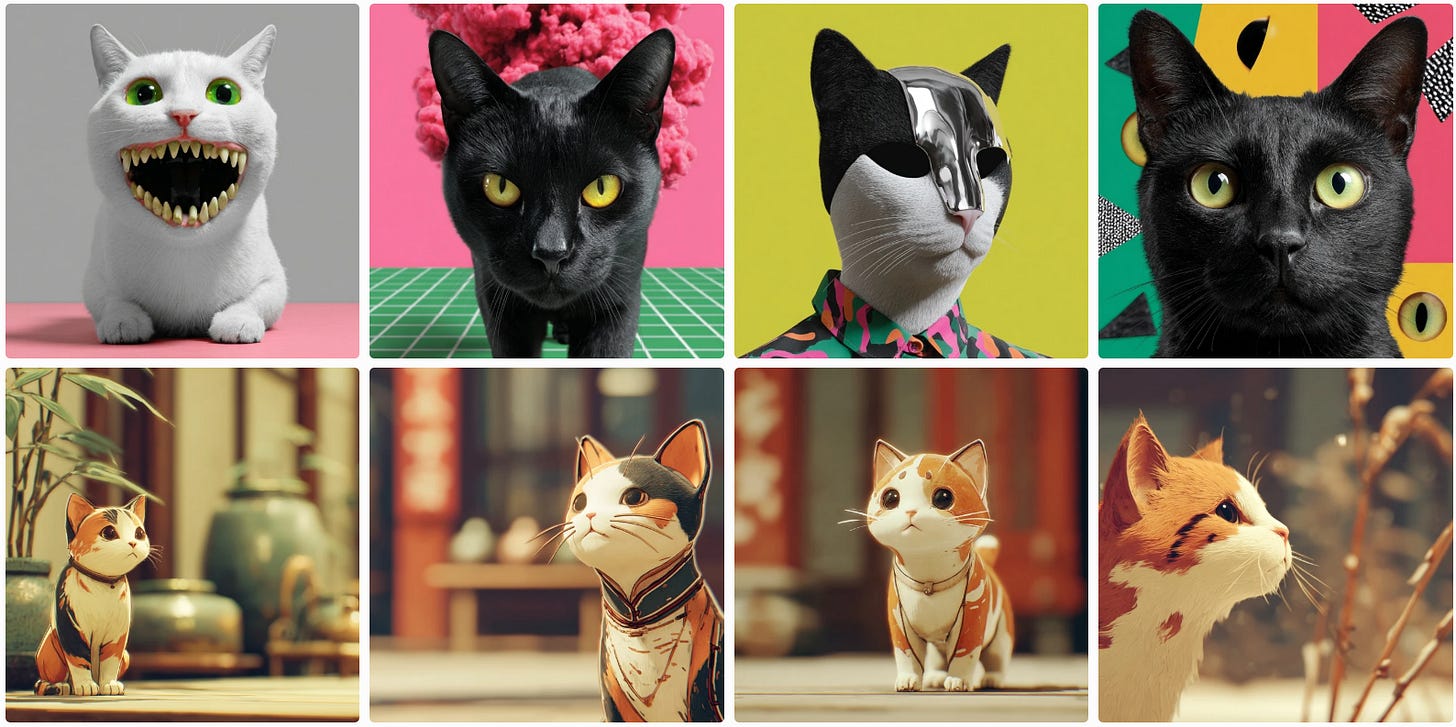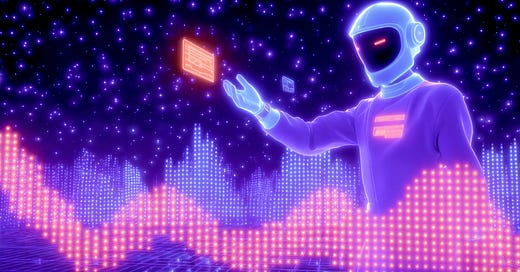Midjourney: Complete overview of the updated Style References (Sref) feature in V7
It's certainly a better Style Reference system
This article has been published ahead of schedule to provide you with tips for shortening your learning curve to master the new Midjourney Style References feature.
Midjourney's massive Style References update
Midjourney has just released a significant update to their Style References (Sref) feature, alongside making V7 the default system.
It isn't just any regular update. It's a new Sref system that broadens the creative possibilities while still supporting legacy codes and styles.
What Style References actually do
Style Reference (Sref) captures the aesthetic vibe of an image and applies it to your new creations.
Unlike Image Reference, Sref doesn't copy the actual objects or subjects. Instead, it captures the overall mood, including colors, textures, lighting, and medium, so that you can maintain consistent visual themes across different prompts.
You've got two main ways to use Sref:
Drop in a Sref code like --sref 2272801577
Upload a reference image directly to the Midjourney website
Pro Tip: If you're creating video content with tools like Runway or Kling, Sref becomes incredibly valuable for keeping color grading and visual consistency across multiple scenes.
What’s new in this update
(1) Backward compatibility with improved functionality
The new system supports both legacy and fresh Sref codes:
Old Sref codes (discovered before June 16th, 2025) still work perfectly
New Sref version 6 (--sv 6) is now the default for V7
Even without specifying it, Midjourney automatically applies --sv 6 to new codes (but it will not show up in the prompt)
Legacy codes need --sv 4 to work properly
You can mine new codes using: . --sref random --v 7
Codes generated from Sref random only work with -sv 4 (for legacy codes) and --sv 6 (for new codes).
When you upload your reference image (instead of using a code), you get access to the full range: --sv 1, --sv 2, --sv 3, --sv 4, --sv 5, and --sv 6. Each version interprets your uploaded image's style differently, giving you more creative choices
(2) Broader aesthetic discovery
The new codes offer a wider variety of styles than before. You can discover aesthetic styles that were previously not found in the legacy system.
(3) Better moodboard accuracy
The moodboard functionality got significantly more accurate, making the style application more predictable.
Video Demo: Using Sref with uploaded image
Let's walk through a practical example. Say you love this vintage "Serves you right" image from the public domain. You can drag and drop it directly onto the Midjourney website as your Style Reference.
Pro Tip: Even though V7 is supposedly the default now, the website can be unpredictable and sometimes reverts to V6.1. Always add --v 7 to be certain.
The video: (no sound)
You'll see the yellow-and-green aesthetic successfully applied to your cat image, maintaining that vintage feel without copying the original subject matter.
The critical difference between legacy and new codes
This part is super important and can make or break your results.
The new system can't automatically detect whether your Sref code is legacy or new. You have to tell it.
Pro Tip: Always add --sv 4 when using Sref codes discovered before the new system launch.
Check out this example with code 1603446285:
Upper row: With --sv 4 (correct for legacy codes):
cat --sref 1603446285 --profile i6fyyx5 --sv 4 --v 7Lower row: Without --sv 4 (wrong for legacy codes):
cat --sref 1603446285 --profile i6fyyx5 --v 7The difference is dramatic - same code, but completely different results.
Here’s another example:
Left:
cat --sref 1603446285 --profile i6fyyx5 --sv 4 --v 7Right:
cat --sref 1603446285 --profile i6fyyx5 --v 7You can artificially modify your legacy Sref code to --v 6
You can artificially modify how legacy codes behave by changing their version parameter:
This produces identical results to not using --sv 4 at all, since the bot automatically applies --sv 6 by default.
Upper row:
cat --sref 1603446285 --profile i6fyyx5 --sv 4 --v 7Lower row:
cat --sref 1603446285 --profile i6fyyx5 --sv 6 --v 7 
New codes work with old parameters too
Even new Sref codes can use --sv 4, but they generate completely different aesthetics.
Take the new code 1359743950:
Default (hidden --sv 6):
. --sref 1359743950 --profile i6fyyx5 --v 7Explicit --sv 4:
. --sref 1359743950 --profile i6fyyx5 --sv 4 --v 7These produce entirely different visual styles from the same code.
Pro Tip: Consider explicitly declaring your Sref version even for new codes. It makes your prompts crystal clear, preventing confusion.
Superior aesthetic application
The new Sref system excels at applying aesthetics even when fighting against completely different native styles.
For example, Sref 287298887 has a clean, minimalistic, black-and-white line style. But watch what happens when you apply it to something totally opposite:
colorful oil painting of a busy wet market --ar 16:9 --sref 287298887 --profile i6fyyx5 --v 7The result maintains the Sref's signature elements:
Black and white color scheme
Clean, minimalistic feel
Still creates the requested oil painting (not rough line sketches)
It's pretty remarkable how well it balances competing style demands.

Technical details worth knowing
(a) Random generation and personalization
Sref Random works with or without Personalization
Results look similar in my (limited) testing
(b) Code handling
Repeated codes get automatically cleaned up (--sref 123 123 becomes --sref 123)
The system is smart enough to avoid redundancy
(c) Version application rules
--sv 4 or --sv 6 apply globally across your entire prompt
If you mix old and new codes, you can only choose one version parameter
No simultaneous application of both versions
(d) Advanced features
Multi-prompt support with weightage for blending multiple Sref styles
Style weight (--sw) parameter for controlling aesthetic intensity
Both multi-prompt weightage and --sw support decimal values
All the flexibility you'd expect from a mature aesthetic system
Example:
New Sref code 1:
. --sref 2588022918 --profile i6fyyx5 --v 7Another Sref code 2:
. --sref 2302673646 --profile i6fyyx5 --v 7Result of bending the Sref codes using multi-prompting technique:
. --sref 2588022918::3 2302673646::2 --profile i6fyyx5 --v 7In contrast of standard 1-to-1 blending
. --sref 2588022918 2302673646 --profile i6fyyx5 --v 7Related articles
Key takeaways
This update represents a significant leap forward in maintaining visual and aesthetic consistency in Midjourney. The backward compatibility ensures that your existing workflows continue to function while the new system opens up broader aesthetic possibilities.
Always be explicit about your Sref version parameters. Whether you're using legacy codes with --sv 4 or experimenting with new codes (--sv 6), declaring your Sref version parameter upfront will make your prompt super clear and save you from unexpected results.
Cover prompt: holographic engineer guiding a fluid system update, virtual dashboard interface, ambient tech glow, cinematic depth --ar 16:9 --sref 2272801577 --profile i6fyyx5 --sv 6
I hope you like this article!
Thank you for reading and happy creating!






















